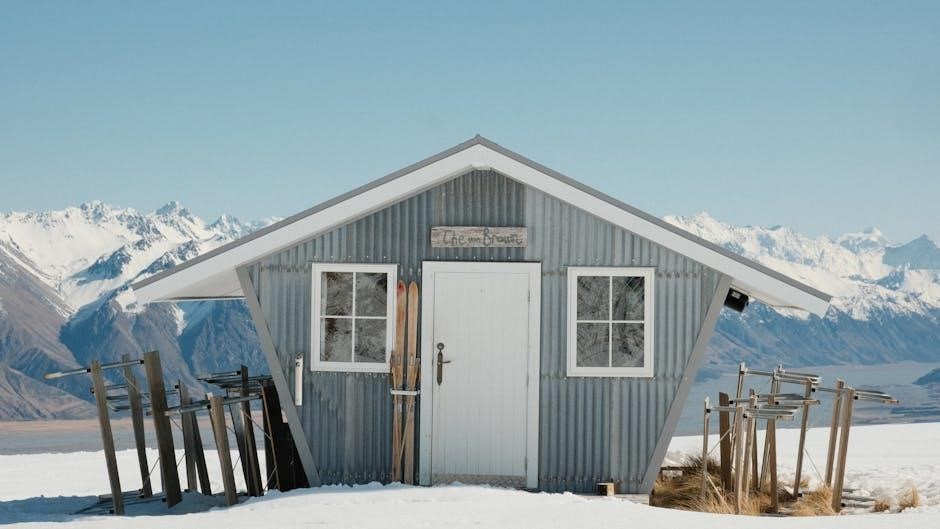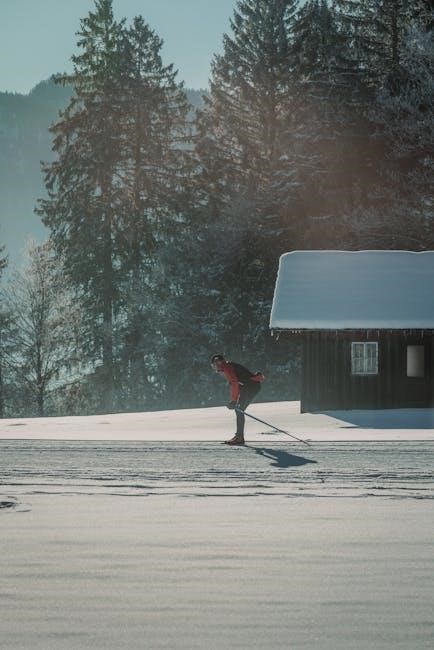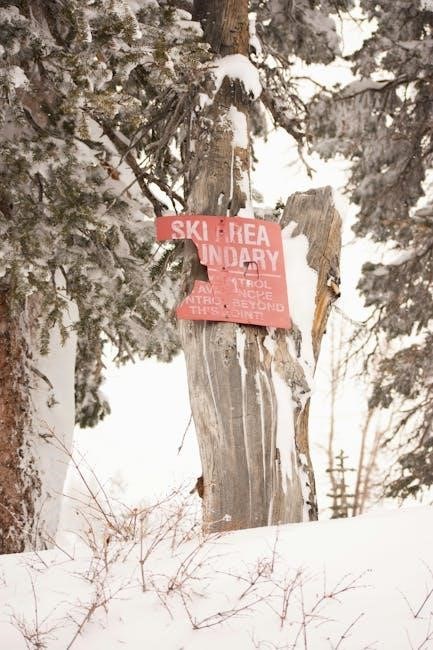backcountry ski guide
Backcountry skiing offers an adventurous alternative to traditional resort skiing, combining physical effort with the thrill of untouched landscapes, fostering a deep connection with nature and freedom.
What is Backcountry Skiing?
Backcountry skiing involves skiing in unmarked, natural environments outside of traditional ski resorts. It requires hiking or climbing to reach untouched snow, offering a unique connection with nature. Unlike resort skiing, backcountry skiing demands self-reliance, as skiers must navigate variable terrain and conditions. Specialized gear, such as skis with climbing skins, enables both uphill and downhill travel. This pursuit combines exploration, physical effort, and the thrill of skiing in pristine landscapes.
History and Evolution
Backcountry skiing traces its roots to ancient Nordic cultures, where skis served as essential tools for transportation. Modern backcountry skiing emerged in the mid-20th century, driven by mountaineers seeking untracked snow. The development of specialized gear, like alpine touring bindings and lightweight materials, revolutionized the sport, making it more accessible. Today, it combines tradition with innovation, appealing to adventurers seeking challenges and pristine landscapes while fostering a community dedicated to exploration and environmental stewardship.
Why Choose Backcountry Skiing?
Backcountry skiing offers a unique escape from crowded resorts, providing untouched powder and breathtaking landscapes. It challenges both body and mind, fostering personal growth and a deeper connection with nature. The sport encourages exploration, solitude, and camaraderie among skiers, while promoting physical fitness and mental resilience. For those seeking adventure and freedom, backcountry skiing delivers an unparalleled skiing experience that combines thrill, challenge, and the beauty of the wild.
Understanding the Basics
Mastering backcountry skiing begins with essential skills like navigation, avalanche safety, and equipment use. These fundamentals ensure safety and enjoyment in the untamed winter environment.
Key Concepts and Terminology
Backcountry skiing involves skiing in remote, unmarked areas outside resorts, requiring specific gear and knowledge. Traversing refers to moving sideways across slopes, while kick-turns help navigate tight spaces. Avalanche safety is crucial, with tools like beacons and probes essential for emergencies. Understanding snow conditions like powder, crust, and ice ensures better decision-making and control on the terrain.
Types of Backcountry Skiing
Ski touring involves climbing uphill using specialized bindings and descending natural terrain. Ski mountaineering combines skiing with mountaineering techniques, often requiring ice axes and crampons. Powder skiing focuses on deep, untouched snow for thrilling descents. Expedition skiing involves multi-day journeys to remote areas, blending adventure with exploration. Each type offers unique challenges and rewards, catering to different skill levels and preferences in the backcountry.
Physical and Mental Demands
Backcountry skiing demands a high level of physical fitness, including endurance, strength, and stamina, as skiers often hike uphill for hours. It also requires mental resilience, focus, and decision-making skills to navigate unpredictable terrain and weather conditions. The ability to assess risks, such as avalanches, and adapt to challenging situations is crucial. Both body and mind must work in harmony to ensure a safe and rewarding experience in the backcountry.

Essential Skills and Safety
Avalanche safety, navigation, and emergency preparedness are critical. Skiers must master risk assessment, decision-making, and crisis management to ensure a safe backcountry skiing experience.
Avalanche Safety and Awareness
Avalanche safety is paramount in backcountry skiing. Understanding avalanche risks, recognizing terrain traps, and using tools like beacons, probes, and shovels are essential. Always check forecasts and assess slopes for stability. Decision-making skills are critical to avoid dangerous situations. Carry safety gear and know how to respond in emergencies. Continuous learning through courses and real-world experience ensures preparedness. Stay informed about conditions and never ski alone in high-risk areas.
Navigation Techniques
Mastering navigation is crucial for backcountry skiing. Use topographic maps, compasses, and GPS devices to stay on track. Plan routes in advance and identify landmarks to avoid disorientation. Learn to read terrain features and use natural navigation cues. Utilize tools like the Search Strategy Builder to refine your pathfinding skills. Always carry a map and compass as a backup to electronic devices. Practice these techniques to ensure safe and efficient travel in remote areas.
Emergency Procedures
In case of an emergency, stay calm and assess the situation. Use communication devices to call for help and activate emergency beacons if necessary. Build a shelter, start a fire, and signal for rescue using reflective objects or smoke. Carry a first aid kit and know basic wilderness medical techniques. Stay visible and conserve energy while waiting for assistance. Always inform someone of your itinerary and expected return time before heading out.

Planning Your Backcountry Adventure
Planning a backcountry ski adventure requires thorough research, careful route selection, and continuous weather monitoring. Ensure all permits are obtained and conduct a safety check before departure.
How to Choose the Right Location
Choosing the right location for backcountry skiing involves assessing your skill level, experience, and the terrain. Consider snow conditions, elevation, and accessibility. Use trail maps, local guides, and weather forecasts to identify safe and suitable routes. Ensure the area aligns with your group’s abilities and interests. Check for permits and regulations, and plan for emergencies. Researching thoroughly ensures a safer and more enjoyable adventure.
Creating a Route Plan
Creating a detailed route plan is essential for a successful backcountry skiing adventure. Start by defining your objectives and assessing your group’s skill level. Use topographical maps, GPS tools, and local guides to identify potential routes. Evaluate snow conditions, terrain difficulty, and avalanche risks. Plan for contingencies, such as emergency exits or alternative paths. Regularly review and adjust your route based on weather forecasts and terrain observations to ensure safety and feasibility.
Weather Forecasting
Accurate weather forecasting is crucial for backcountry skiing. Check local forecasts and use specialized tools like mountain weather apps. Monitor snow conditions, wind, and temperature trends. Be aware of rapid weather changes in high-altitude areas. Understanding weather patterns helps assess snow stability and avalanche risks. Always verify forecasts before heading out and adjust plans according to conditions to ensure safety and a successful adventure.
Backcountry Skiing Gear
Essential gear includes skis, bindings, boots, poles, avalanche safety tools, and appropriate clothing. Each item must be durable, lightweight, and tailored for off-trail performance and safety.
Skis and Bindings
Backcountry skis are designed for traversal across varied terrain, often lighter and wider for better float in powder. Bindings must be durable, with features like touring modes for uphill efficiency.
Boots and Poles
Backcountry skiing boots are designed for both uphill mobility and downhill performance, offering a balance of stiffness and flexibility. Look for waterproof materials and a comfortable fit for long tours. Poles are lightweight yet durable, often adjustable in length to accommodate varying terrain. They feature ergonomic grips and durable baskets, ensuring reliability on both ascents and descents in challenging backcountry conditions.
Clothing and Accessories
Dressing appropriately is crucial for backcountry skiing. Layer with a breathable base, insulating mid-layer, and waterproof shell to regulate temperature. Moisture-wicking fabrics and venting systems help manage sweat. Accessories like gloves, hats, and goggles protect from harsh conditions. Gaiters and gators prevent snow entry, while avalanche transceivers, probes, and shovels are essential for safety. Choose gear that balances functionality, comfort, and durability for optimal performance in the backcountry environment.

Advanced Techniques
Mastering backcountry skiing involves refining skills like turning, control, and rhythm on diverse terrains. Elevate your abilities by practicing techniques that enhance efficiency and adaptability in challenging conditions.
Mastering Different Terrains
Backcountry skiing demands adaptability across diverse terrains, from powdery slopes to icy chutes. Techniques vary: maintain speed on flat sections, carve precise turns in tight trees, and balance on uneven ground. Practice transitioning between snow types, such as crust or slush, to build confidence. Steep terrain requires strong edge control and mental focus. Mastery comes with experience, refining skills to conquer any landscape encountered in the wilderness.
Improving Efficiency
Efficiency in backcountry skiing is key to enjoying longer, more rewarding tours. Choose lightweight gear to reduce exertion and refine techniques like skinning and kick-turns to conserve energy. Plan routes that minimize backtracking and use terrain features like ridges or bowls to glide effortlessly. Practice transitions between walking and skiing to save time. Building physical conditioning and stamina will also enhance your ability to explore further and ski more dynamically in the wilderness.
Respect and Etiquette
Respect for nature, others, and local regulations is essential in backcountry skiing. Always follow Leave No Trace principles, minimizing waste and avoiding sensitive habitats. Yield to other skiers, hikers, and wildlife, ensuring a shared enjoyment of the terrain. Be mindful of private property rights and adhere to local access rules. Practicing respect fosters a positive reputation for backcountry skiers and preserves these pristine environments for future generations to explore and appreciate.

Environmental Considerations
Respecting nature is crucial for preserving backcountry skiing ecosystems. Minimize environmental impact by adhering to Leave No Trace principles and staying on designated trails to protect wildlife habitats.
Minimizing Impact
When backcountry skiing, it’s essential to minimize your environmental footprint. Stay on designated trails to prevent erosion and avoid sensitive habitats. Pack out all trash and avoid littering. Respect wildlife by maintaining a safe distance and not disturbing their natural behaviors. Use biodegradable products and refrain from unnecessary campfire use. By adopting these practices, you help preserve the pristine landscapes for future generations of skiers and nature enthusiasts alike.
Local Regulations
Understanding and adhering to local regulations is crucial for backcountry skiing. Always obtain necessary permits and respect access restrictions to protected areas. Familiarize yourself with rules regarding camping, fires, and waste disposal. Compliance ensures sustainable access and preserves natural environments. Ignoring regulations can result in fines or bans. Verify information through local authorities or visitor centers for the most accurate and up-to-date guidelines before heading out.
Leave No Trace
Adhering to the Leave No Trace philosophy is essential for preserving the pristine beauty of backcountry landscapes. Key principles include minimizing impact by staying on designated trails, disposing of waste properly, and avoiding disturbance of wildlife. By respecting these guidelines, skiers help maintain the integrity of natural environments for future generations. This mindful approach ensures that backcountry areas remain untouched and accessible for everyone to enjoy;
Backcountry skiing offers unparalleled adventure and personal growth, rewarding those who embrace the challenge. Continuous learning and respect for nature ensure a safe and fulfilling experience for all.
Final Thoughts
Backcountry skiing is a transformative experience that combines physical challenge, mental focus, and deep connections with nature. It demands dedication, continuous learning, and respect for the environment. Embrace the journey, stay curious, and prioritize safety. The rewards of untouched landscapes and personal growth make every effort worthwhile. Remember, the mountains are a classroom—listen, adapt, and thrive. Respect the land, honor the community, and cherish the freedom that backcountry skiing offers.
Encouragement to Explore
Embrace the thrill of backcountry skiing and uncover the hidden gems of the wilderness. Every turn in untouched snow is a testament to your adventure spirit. Whether you’re a seasoned skier or just starting, the journey offers endless opportunities for growth and connection with nature. Step beyond the resorts and discover landscapes that inspire and challenge you. The backcountry awaits—explore, learn, and let the mountains shape your story.
Continuous Learning
Continuous learning is vital for mastering backcountry skiing. Stay updated on avalanche safety, navigation, and environmental awareness. Engage with workshops, guides, and online resources to refine skills and adapt to evolving conditions. Practice regularly to build confidence and efficiency. Embrace challenges and seek feedback to improve. The backcountry demands lifelong learning, ensuring safer and more rewarding experiences. Dedication to growth will enhance your connection with the wilderness and the sport.


